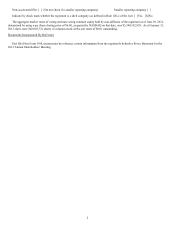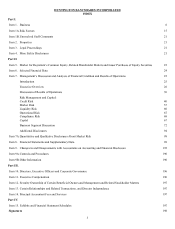Huntington National Bank 2012 Annual Report Download - page 20
Download and view the complete annual report
Please find page 20 of the 2012 Huntington National Bank annual report below. You can navigate through the pages in the report by either clicking on the pages listed below, or by using the keyword search tool below to find specific information within the annual report.
12
xTier 1 risk-based capital, or core capital, which includes total equity plus qualifying capital securities and minority interests,
excluding unrealized gains and losses accumulated in other comprehensive income, and nonqualifying intangible and
servicing assets.
xTier 2 risk-based capital, or supplementary capital, which includes, among other things, cumulative and limited-life preferred
stock, mandatory convertible securities, qualifying subordinated debt, and the ACL, up to 1.25% of risk-weighted assets.
xTotal risk-based capital is the sum of Tier 1 and Tier 2 risk-based capital.
The Federal Reserve and the other federal banking regulators require that all intangible assets (net of deferred tax), except
originated or purchased MSRs, nonmortgage servicing assets, and purchased credit card relationships intangible assets, be deducted
from Tier 1 capital. However, the total amount of these items included in capital cannot exceed 100% of its Tier 1 capital.
Under the risk-based guidelines to remain adequately-capitalized, financial institutions are required to maintain a total risk-based
capital ratio of 8%, with 4% being Tier 1 risk-based capital. The appropriate regulatory authority may set higher capital requirements
when they believe an institution's circumstances warrant.
Under the leverage guidelines, financial institutions are required to maintain a Tier 1 leverage ratio of at least 3%. The minimum
ratio is applicable only to financial institutions that meet certain specified criteria, including excellent asset quality, high liquidity, low
interest rate risk exposure, and the highest regulatory rating. Financial institutions not meeting these criteria are required to maintain a
minimum Tier 1 leverage ratio of 4%.
Failure to meet applicable capital guidelines could subject the financial institution to a variety of enforcement remedies available
to the federal regulatory authorities. These include limitations on the ability to pay dividends, the issuance by the regulatory authority
of a directive to increase capital, and the termination of deposit insurance by the FDIC. In addition, the financial institution could be
subject to the measures described below under Prompt Corrective Action as applicable to under-capitalized institutions.
The risk-based capital standards of the Federal Reserve, the OCC, and the FDIC specify that evaluations by the banking agencies
of a bank's capital adequacy will include an assessment of the exposure to declines in the economic value of a bank's capital due to
changes in interest rates. These banking agencies issued a joint policy statement on interest rate risk describing prudent methods for
monitoring such risk that rely principally on internal measures of exposure and active oversight of risk management activities by
senior management.
FDICIA requires federal banking regulatory authorities to take Prompt Corrective Action with respect to depository institutions
that do not meet minimum capital requirements. For these purposes, FDICIA establishes five capital tiers: well-capitalized,
adequately-capitalized, under-capitalized, significantly under-capitalized, and critically under-capitalized.
Throughout 2012, our regulatory capital ratios and those of the Bank were in excess of the levels established for well-capitalized
institutions. An institution is deemed to be well-capitalized if it has a total risk-based capital ratio of 10% or greater, a Tier 1 risk-
based capital ratio of 6% or greater, and a Tier 1 leverage ratio of 5% or greater and is not subject to a regulatory order, agreement, or
directive to meet and maintain a specific capital level for any capital measure.
At December 31, 2012
Well-capitalized Excess
(dollar amounts in billions) minimums Actual Capital (1)
Ratios:
Tier 1 leverage ratio Consolidated 5.00 % 10.36 % $ 3.0
Bank 5.00 9.05 2.2
Tier 1 risk-based capital ratio Consolidated 6.00 12.02 2.9
Bank 6.00 10.49 2.1
Total risk-based capital ratio Consolidated 10.00 14.50 2.2
Bank 10.00 12.78 1.3
(1) Amount greater than the well-capitalized minimum percentage.
























